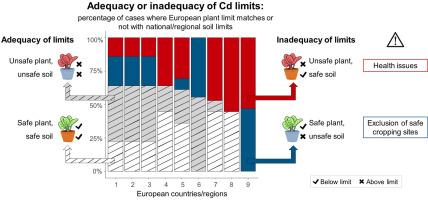用菠菜作为痕量金属生物利用度指标:污染限值对植物和土壤有效吗?
IF 7.3
2区 环境科学与生态学
Q1 ENVIRONMENTAL SCIENCES
引用次数: 0
摘要
土壤微量金属污染是影响食品安全和人类健康的世界性问题。在欧洲,一项法规规定了食品中TM的最高水平(MLs),以保护消费者。同样,欧洲国家或地区对TM采用土壤作用值(sav),高于TM的农田被认为受到污染(即对食品生产不安全)。这些sav因国家/地区的不同而不同,就其值本身和/或用于测量土壤TM浓度的提取方法而言。我们在36种土壤基质上种植了菠菜,并评估了(1)9个欧洲国家/地区实施的土壤TM限制在预测菠菜TM浓度是否超过ml方面的充分性,以及(2)8种化学萃取剂(CaCl2, NaNO3, NH4NO3, DTPA, AcEDTA,两种浓度的HNO3和王水)在预测与菠菜浓度相关的土壤TM浓度方面的预测有效性。我们的结果显示,在某些欧洲土壤限制适用于比利时土壤,以确保符合食品MLs显着的缺点。具体来说,我们证明了通常用于建立土壤限制的萃取剂通常是菠菜TM浓度的不良预测因子。对于所有TM组合,我们确定螯合盐萃取剂(DTPA和AcEDTA)是预测植物浓度最可靠的折衷方案。基于这些结果,我们提出了目前在欧洲使用的每种萃取剂的sav修订,以及针对所确定的最佳萃取剂量身定制的新sav。我们相信这些发现对于加强土壤管理和保护公众健康至关重要。本文章由计算机程序翻译,如有差异,请以英文原文为准。

Use of spinach as an indicator of trace metal bioavailability: Are contamination limits valid for plants and soil?
Soil trace metal (TM) contamination is a worldwide issue affecting food safety and human health. In Europe, a regulation sets maximum levels (MLs) of TM in food to protect consumers. Similarly, European countries or regions apply soil action values (SAVs) for TM above which croplands are considered contaminated (i.e. unsafe for food production). These SAVs differ from one country/region to another, in terms of the values themselves and/or the extraction methods used to measure soil TM concentrations. We grew spinach plants on 36 substrates with previous anthropogenic TM contamination and evaluated (1) the adequacy of soil TM limits implemented across nine European countries/regions in predicting whether spinach TM concentrations exceed MLs, and (2) the predictive effectiveness of eight chemical extractants (CaCl2, NaNO3, NH4NO3, DTPA, AcEDTA, two concentrations of HNO3 and aqua regia) in estimating soil TM concentrations relevant to spinach concentrations.
Our results reveal significant shortcomings in certain European soil limits (i.e. SAVs) applied to Belgian soils in ensuring the compliance with food MLs. Specifically, we demonstrate that the extractants commonly used to establish SAVs are generally poor predictors of spinach TM concentrations. For all TM combined, we identified chelating-saline extractants (DTPA and AcEDTA) as the most reliable compromise for predicting plant TM concentrations. Based on these results, we propose a revision of SAVs for each extractant used currently in Europe, as well as new SAVs tailored to the optimal extractants identified. We believe these findings are critical for enhancing soil regulations and protecting public health.
求助全文
通过发布文献求助,成功后即可免费获取论文全文。
去求助
来源期刊

Environmental Pollution
环境科学-环境科学
CiteScore
16.00
自引率
6.70%
发文量
2082
审稿时长
2.9 months
期刊介绍:
Environmental Pollution is an international peer-reviewed journal that publishes high-quality research papers and review articles covering all aspects of environmental pollution and its impacts on ecosystems and human health.
Subject areas include, but are not limited to:
• Sources and occurrences of pollutants that are clearly defined and measured in environmental compartments, food and food-related items, and human bodies;
• Interlinks between contaminant exposure and biological, ecological, and human health effects, including those of climate change;
• Contaminants of emerging concerns (including but not limited to antibiotic resistant microorganisms or genes, microplastics/nanoplastics, electronic wastes, light, and noise) and/or their biological, ecological, or human health effects;
• Laboratory and field studies on the remediation/mitigation of environmental pollution via new techniques and with clear links to biological, ecological, or human health effects;
• Modeling of pollution processes, patterns, or trends that is of clear environmental and/or human health interest;
• New techniques that measure and examine environmental occurrences, transport, behavior, and effects of pollutants within the environment or the laboratory, provided that they can be clearly used to address problems within regional or global environmental compartments.
 求助内容:
求助内容: 应助结果提醒方式:
应助结果提醒方式:


